# Box
Box (opens new window) is a cloud content management and file sharing service for businesses. The Box platform enables secure and easy team collaboration on-the-go.
# Use cases
Integrate the Box connector with your business applications to enhance collaboration and file management. You can automate document sharing, improve approvals workflows, and securely transfer data across platforms. Explore our use cases to discover how you can optimize your Box workflows:
- Invite DocuSign signees to collaborate in Box and notify your team in Slack.
- Load Box CSV data to Google BigQuery with Google Cloud Storage.
# API version
The Box connector uses Box Rest API v2 (opens new window).
# Supported editions and versions
The Box connector works with all Box plans.
# How to connect to Box on Workato
The Box connector supports the following authentication methods:
# Roles and permissions required to connect
Your Workato permissions match the permissions you have in Box. This means that you have the same capabilities to view, share, upload, and download files and folders in Workato that you have on the Box platform. Refer to Box privileges and permissions for more information.
BOX REFRESH TOKEN
Box Refresh Tokens enable you to acquire a new Access Token for Box. However, each Box Refresh Token is valid for only one use within a 60-day period. Consequently, if you maintain an active connection to Box but refrain from using any Box actions for 60 days, an error occurs when you try to perform a Box action.
Refer to the Box documentation to learn how to manage your access using Box Refresh Tokens (opens new window).
# Authorization code grant
Complete the following steps to set up your Box connection using authorization code grant authentication:
Provide a name that identifies which Box instance Workato is connected to in the Connection name field.
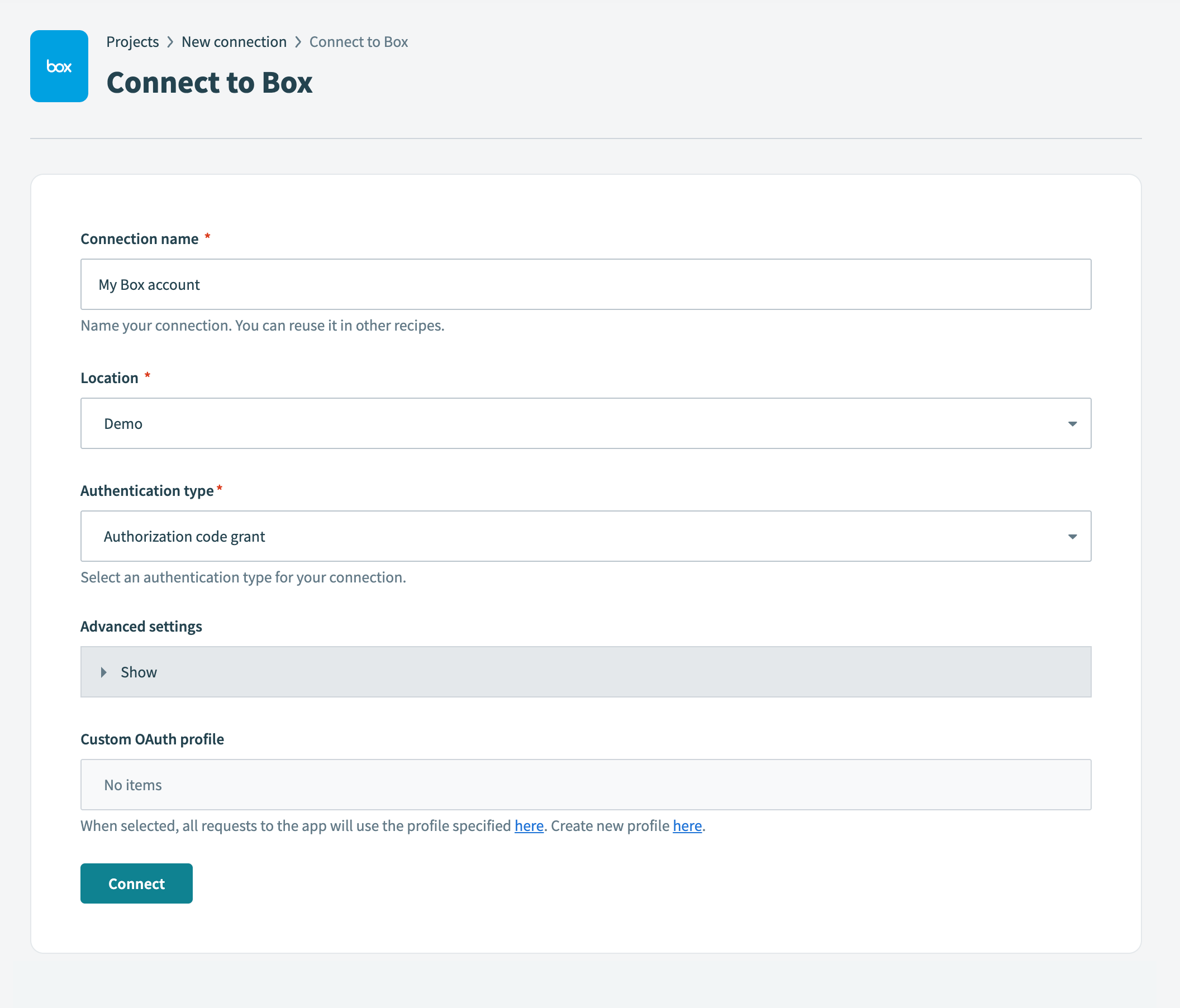 Create your connection
Create your connection
Use the Authentication type drop-down menu to select Authorization code grant.
Optional. Expand Advanced settings to select Requested permissions (Oauth scopes) options.
You can select from the following scopes:
- Read files and folders
- Read and write files and folders
- Manage app users
- Manage managed users
- Manage groups
- Manage webhooks
- Manage enterprise properties
- Manage retention policies
- Global content manager
- Admin can make calls on behalf of users
- Manage signature requests
- Manage Box Relay
Click Connect. This opens the Box sign in dialog.
Enter your Box account email address and password.
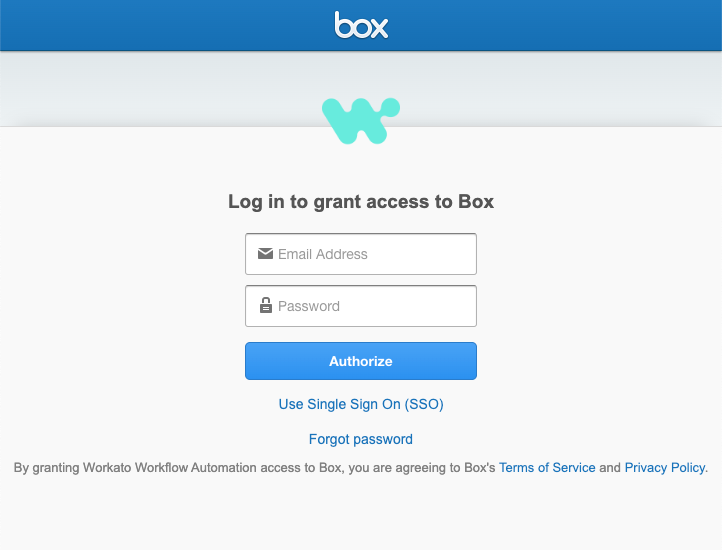 Log in to Box
Log in to Box
Click Authorize.
Review the requested permissions and click Grant access to Box.
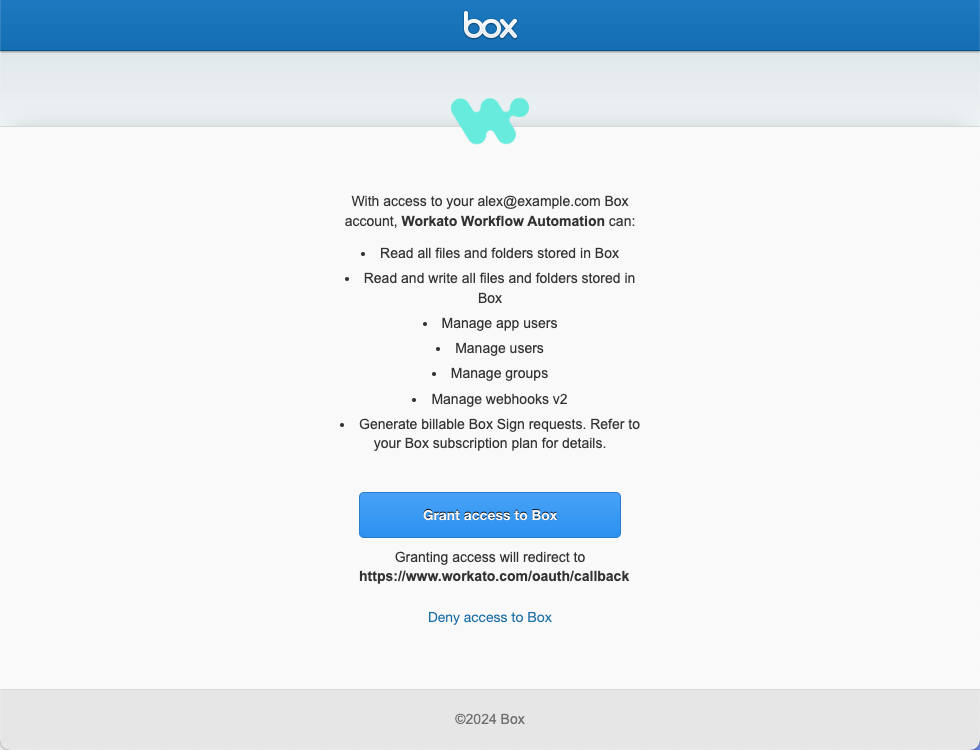 Grant access to Box
Grant access to Box
# Client credentials
Complete the following steps to set up your Box connection using client credentials authentication:
Create a custom app.
Sign in to your Box account.
Go to Dev Console > My Apps.
Click Create New App.
Select Custom App as the app type to create.
Enter your app name in the App Name field.
Enter your app description in the Description field.
Use the Purpose drop-down menu to select Automation.
Click Next.
Select Server Authentication (Client Credentials Grant) as your authentication method.
Click Create App. This opens the Configuration tab.
Get required values.
Scroll to the OAuth 2.0 Credentials section and copy the Client ID. Store this value securely, as it is required to configure your Box connection in Workato.
Click Fetch Client Secret. This opens a 2-Step Verification page.
Enter the 6-digit code from your authenticator app in the Authentication Code field. This reveals the Client Secret field.
Click Copy to retrieve the client secret. Store this value securely, as it is required to configure your Box connection in Workato.
Scroll to the App Access Level section and select App + Enterprise Access.
Click Save Changes.
Click the General Settings tab and copy either the User ID or the Enterprise ID. Use the User ID if the authentication subject type is a managed user, or the Enterprise ID if it is a service account. Store this value securely, as it is required to configure your Box connection in Workato.
Submit the app for authorization.
Go to the Authorization tab and click Review and Submit.
Review your app authorization submission and click Submit.
Click Back to My Account.
Authorize the app.
Go to Admin Console > Integrations > Platform Apps Manager.
Hover over the app you submitted for authorization and click … More.
Select Authorize App.
Review the information and click Authorize.
Sign in to Workato and create a new Box connection.
Provide a name that identifies which Box instance Workato is connected to in the Connection name field.
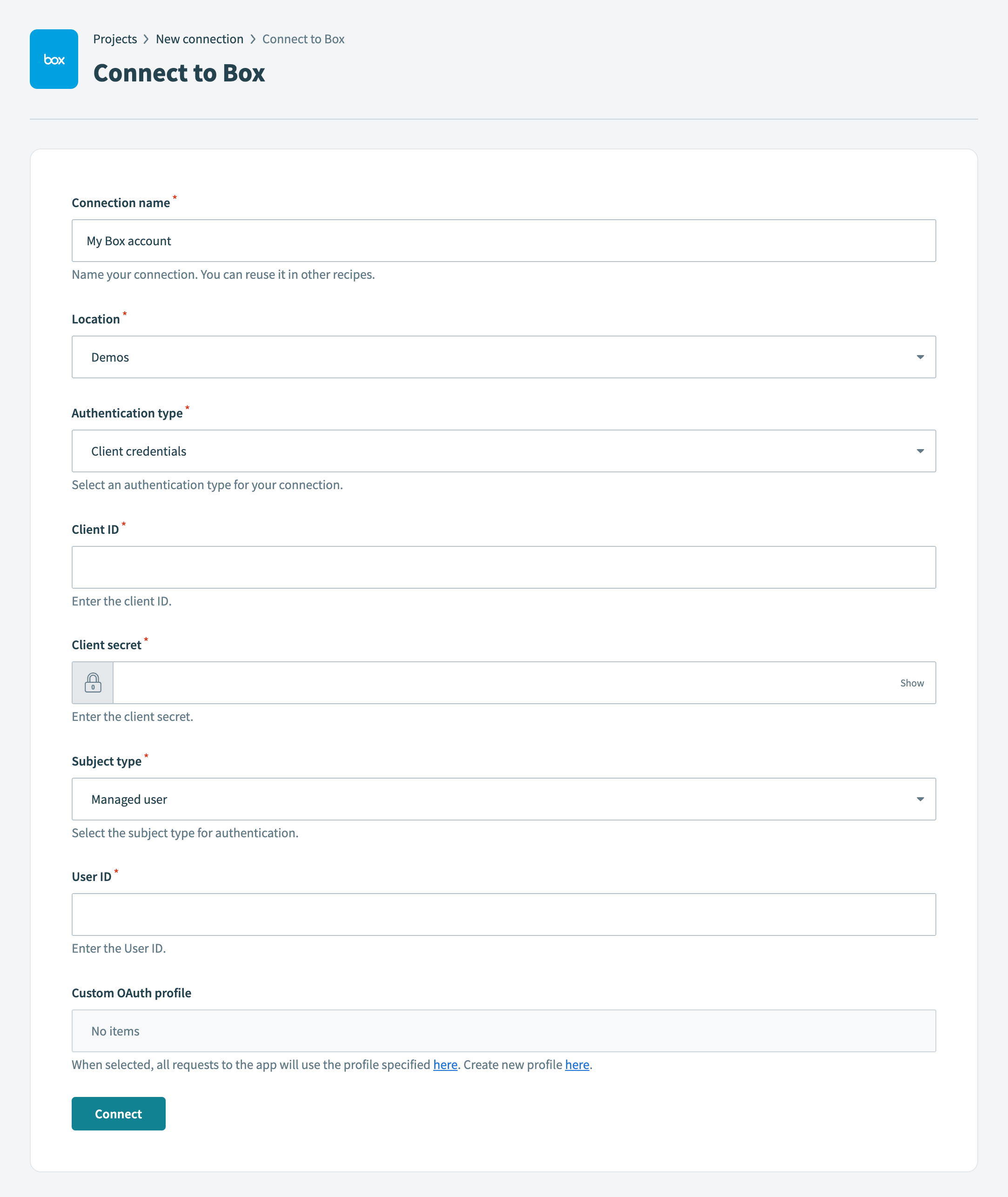 Connect to Box using client credentials authentication
Connect to Box using client credentials authentication
Use the Location drop-down menu to select the project or folder where you plan to store your connection.
Select Client credentials from the Authentication type drop-down menu.
Enter the client ID from the Get required values step in the Client ID field.
Enter the client secret from the Get required values step in the Client secret field.
Use the Subject type drop-down menu to select your subject type. Available options include Managed user and Service account.
- Managed user: Enter the user ID from the Get required values step in the User ID field.
- Service account: Enter the enterprise ID from the Get required values step in the Enterprise ID field.
Optional. Specify the custom OAuth profile you plan to use for this connection in the Custom OAuth profile field.
Click Connect.
# Working with attachments in Box
# Upload file content
You can upload plain text file content using this action.
Enter the text for your file in the File Content field.
Select the folder you plan to upload in Box.
Enter a name for the file, including the extension.
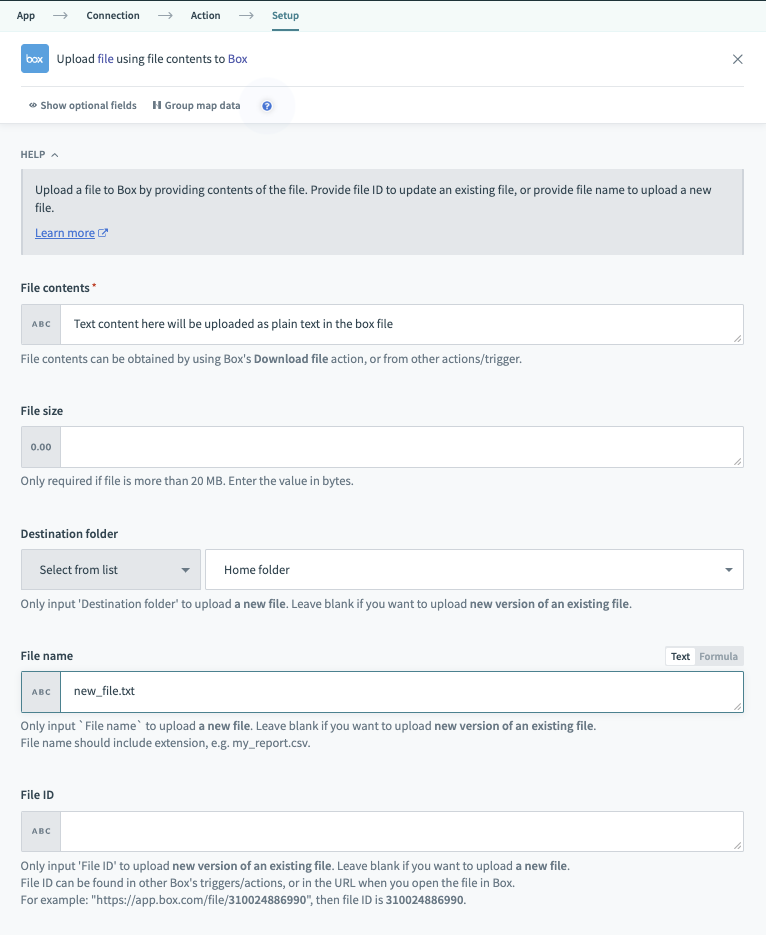 Upload file content
Upload file content
# Upload file from URL
You can upload a file directly from a URL rather than entering text content. This allows you to upload non-text files such as images.
Enter the URL for the file you plan to upload in the Source URL field. Attachment URLs typically end with the file extension for the file (such as .jpg).
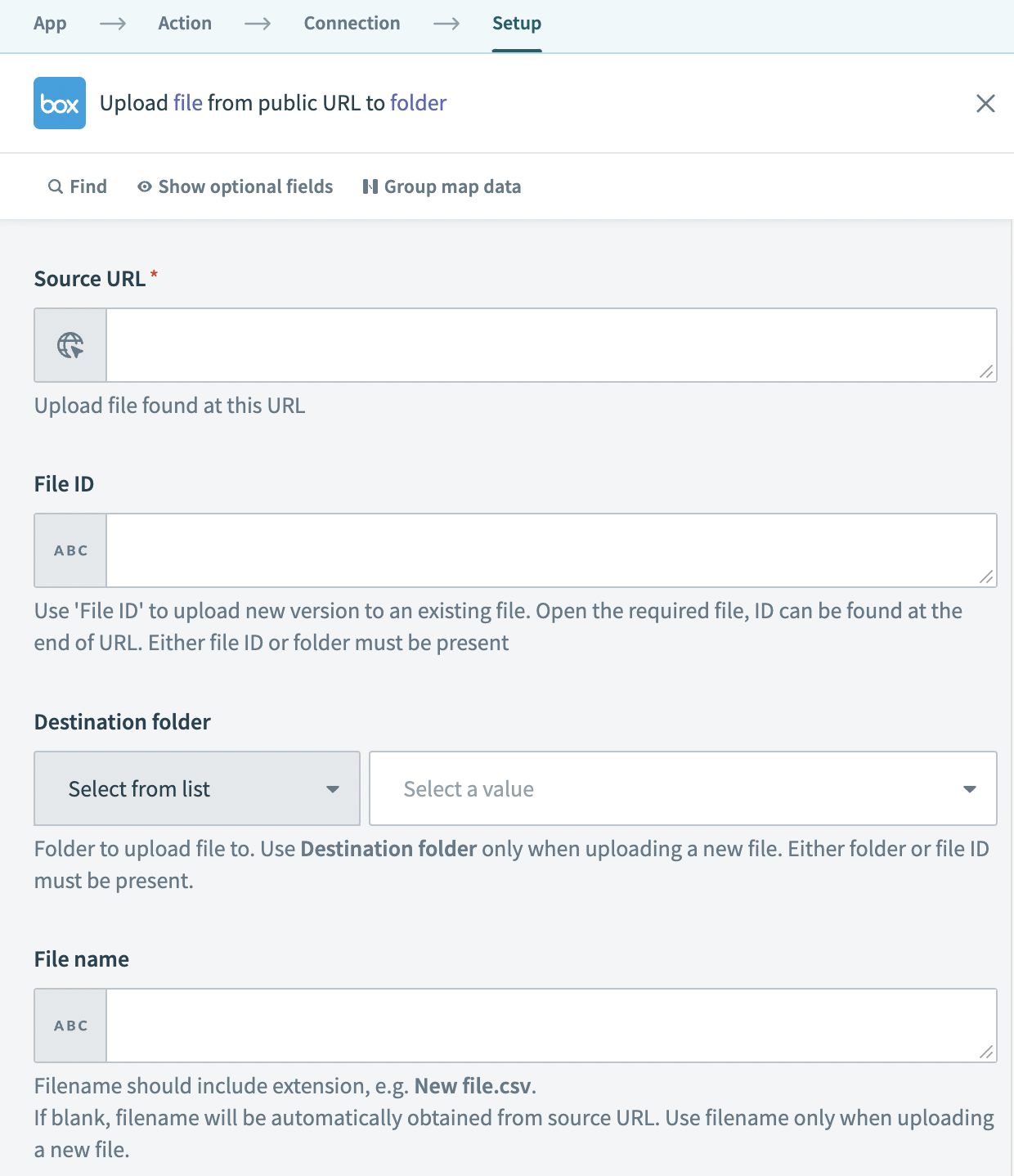 Upload file from URL
Upload file from URL
Select the Destination folder where you plan to upload your file. Note that entering a file name is optional as Workato obtains the name of the file from the URL by default.
# Create and use shared links to Box folder/file
The Create shared link action allows you to create a direct link to a file or folder in Box.
Enter the file ID/folder ID for the file/folder for which you plan to create a shared link.
Select an access level for the shared link (Open, Company, Collaborators, or Default). Refer to Shared link permissions for more information.
This sets restrictions on who can view your file/folder using the shared link. If you have a Premium Box subscription, you can also enter a password that link-users must enter before they can access your file/folder.
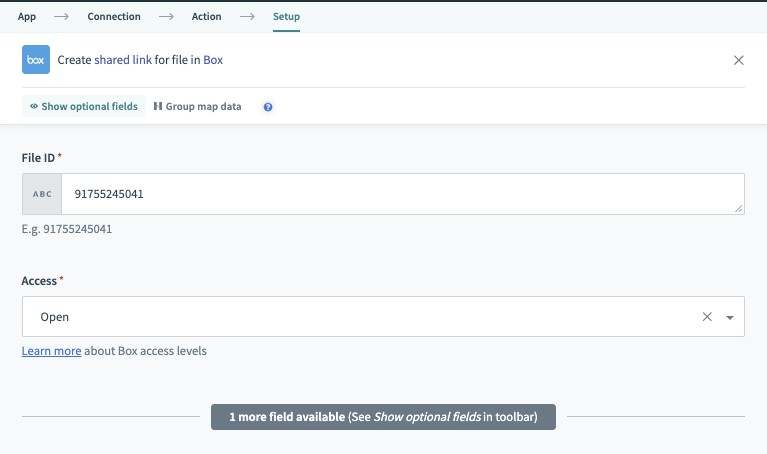 Create shared links
Create shared links
Optional. Use the ID Step 1 datapill from the trigger step to identify the new file when creating the shared URL link, and post the URL in the following schema to your Slack Workbot.
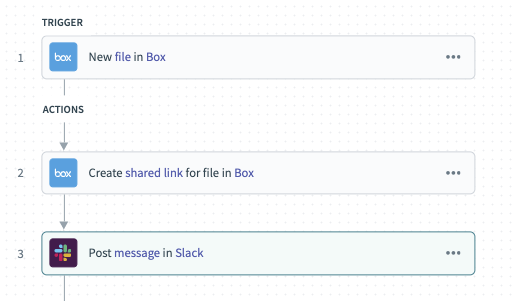
 Post the URL in Slack Workbot
Post the URL in Slack Workbot
# Box privileges and permissions
# Box role privileges
When using Box with Workato, you can only perform the actions that are allowed by the level of access you have in the Box account used to make the connection to Workato. The following table describes the available Box role privileges.
| Levels | Access |
|---|---|
| Uploader | Can only upload content and see names of items in the folder. Cannot view or download any content. |
| Previewer | Can only preview items in the folder. Cannot upload, edit, delete, or share any content. |
| Viewer | Can preview/download content, make comments, and generate shared links. Cannot add tags, invite new collaborators, edit shared links, or upload/edit/delete items in the folder. |
| Previewer uploader | Can preview content, add comments, add tasks, and upload content to the folder. Cannot add tags, generate shared links, invite new collaborators, or edit/delete items in the folder. |
| Viewer uploader | Can preview content, download content, add comments, generate shared links, and upload content to the folder. Cannot add tags, invite new collaborators, or delete items in the folder. Can still download, edit, and re-upload files under the same name manually or using Box Edit. |
| Editor | Can view, download, upload, edit, delete, copy, move, and rename content. Can also generate/edit shared links, make comments, assign tasks, create tags, and invite/remove collaborators. Cannot delete or move root level folders. |
| Co-owner | Has all permissions of an editor. Can also manage users in the folder: add new collaborators, change access levels of collaborators, remove collaborators. |
| Owner | Full access. |
# Shared link permissions
When creating a shared link for a file or folder in Box, you can choose from four different options for access levels, as shown below.
| Levels | Access |
|---|---|
| Open | Anyone with the link can access the file or folder. A Box account is not required. |
| Company | Only Box users with a validated email address matching your company's domain can access the file or folder via the shared link. |
| Collaborators | Only Box users invited to the folder or file (collaborators) can access the file or folder via the shared link. |
| Default | This option follows whatever the default setting for your account is. You can view and change this in your Box account settings under Content and Sharing. |
Last updated: 12/17/2025, 6:17:46 PM